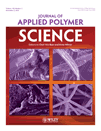Synthesis and characterization of temperature-sensitive block copolymers from poly(N-isopropylacrylamide) and 4-methyl-ε-caprolactone or 4-phenyl-ε-caprolactone
Abstract
This study synthesizes thermally sensitive block copolymers poly(N-isopropylacrylamide)-b-poly(4-methyl-ε-caprolactone) (PNIPA-b-PMCL) and poly(N-isopropylacrylamide)-b-poly(4-phenyl-ε-caprolactone) (PNIPA-b-PBCL) by ring-opening polymerization of 4-methyl-ε-caprolactone (MCL) or 4-phenyl-ε-caprolactone (BCL) initiated from hydroxy-terminated poly(N-isopropylacrylamide) (PNIPA) as the macroinitiator in the presence of SnOct2 as the catalyst. This research prepares a PNIPA bearing a single terminal hydroxyl group by telomerization using 2-hydroxyethanethiol (ME) as a chain-transfer agent. These copolymers are characterized by differential scanning calorimetry (DSC), 1H-NMR, FTIR, and gel permeation chromatography (GPC). The thermal properties (Tg) of diblock copolymers depend on polymer compositions. Incorporating larger amount of MCL or BCL into the macromolecular backbone decreases Tg. Their solutions show transparent below a lower critical solution temperature (LCST) and opaque above the LCST. LCST values for the PNIPA-b-PMCL aqueous solution were observed to shift to lower temperature than that for PNIPA homopolymers. This work investigates their micellar characteristics in the aqueous phase by fluorescence spectroscopy, transmission electron microscopy (TEM), and dynamic light scattering (DLS). The block copolymers formed micelles in the aqueous phase with critical micelle concentrations (CMCs) in the range of 0.29–2.74 mg L−1, depending on polymer compositions, which dramatically affect micelle shape. Drug entrapment efficiency and drug loading content of micelles depend on block polymer compositions. © 2010 Wiley Periodicals, Inc. J Appl Polym Sci, 2010




